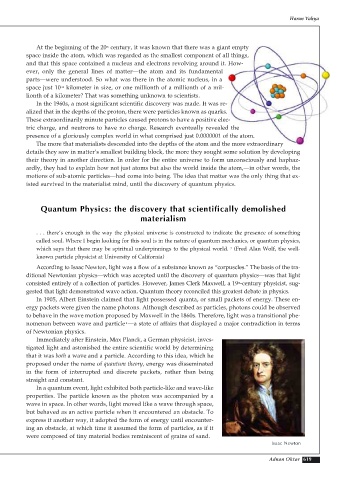Page 621 - Atlas of Creation Volume 4
P. 621
Harun Yahya
At the beginning of the 20 century, it was known that there was a giant empty
th
space inside the atom, which was regarded as the smallest component of all things,
and that this space contained a nucleus and electrons revolving around it. How-
ever, only the general lines of matter—the atom and its fundamental
parts—were understood. So what was there in the atomic nucleus, in a
space just 10 kilometer in size, or one millionth of a millionth of a mil-
-18
lionth of a kilometer? That was something unknown to scientists.
In the 1960s, a most significant scientific discovery was made. It was re-
alized that in the depths of the proton, there were particles known as quarks.
These extraordinarily minute particles caused protons to have a positive elec-
tric charge, and neutrons to have no charge. Research eventually revealed the
presence of a gloriously complex world in what comprised just 0.0000001 of the atom.
The more that materialists descended into the depths of the atom and the more extraordinary
details they saw in matter’s smallest building block, the more they sought some solution by developing
their theory in another direction. In order for the entire universe to form unconsciously and haphaz-
ardly, they had to explain how not just atoms but also the world inside the atom,—in other words, the
motions of sub-atomic particles—had come into being. The idea that matter was the only thing that ex-
isted survived in the materialist mind, until the discovery of quantum physics.
Quantum Physics: the discovery that scientifically demolished
materialism
. . . there’s enough in the way the physical universe is constructed to indicate the presence of something
called soul. Where I begin looking for this soul is in the nature of quantum mechanics, or quantum physics,
which says that there may be spiritual underpinnings to the physical world. (Fred Alan Wolf, the well-
7
known particle physicist at University of California)
According to Isaac Newton, light was a flow of a substance known as “corpuscles.” The basis of the tra-
ditional Newtonian physics—which was accepted until the discovery of quantum physics—was that light
consisted entirely of a collection of particles. However, James Clerk Maxwell, a 19 -century physicist, sug-
th
gested that light demonstrated wave action. Quantum theory reconciled this greatest debate in physics.
In 1905, Albert Einstein claimed that light possessed quanta, or small packets of energy. These en-
ergy packets were given the name photons. Although described as particles, photons could be observed
to behave in the wave motion proposed by Maxwell in the 1860s. Therefore, light was a transitional phe-
nomenon between wave and particle —a state of affairs that displayed a major contradiction in terms
8
of Newtonian physics.
Immediately after Einstein, Max Planck, a German physicist, inves-
tigated light and astonished the entire scientific world by determining
that it was both a wave and a particle. According to this idea, which he
proposed under the name of quantum theory, energy was disseminated
in the form of interrupted and discrete packets, rather than being
straight and constant.
In a quantum event, light exhibited both particle-like and wave-like
properties. The particle known as the photon was accompanied by a
wave in space. In other words, light moved like a wave through space,
but behaved as an active particle when it encountered an obstacle. To
express it another way, it adopted the form of energy until encounter-
ing an obstacle, at which time it assumed the form of particles, as if it
were composed of tiny material bodies reminiscent of grains of sand.
Isa ac New ton
Adnan Oktar 619

